Over the years, the United States has produced many remarkable generals and admirals, but only a few have stood out as world-class strategists and leaders of troops. As Veterans Day approaches on November 11, let’s remember and celebrate them. Here is my list of America’s finest 11 commanders.
George Washington 1732 – 1799, (Revolutionary War)
At Washington’s funeral in 1799, “Lighthorse Harry” Lee famously said of his beloved commander that he was “first in war, first in peace, first in the hearts of his countrymen.” As our new nation’s “indispensable man” one simply cannot imagine the American victory over the British, and thus gaining her independence, without the towering figure of George Washington as leader of the Continental Army and the face of the rebellion.
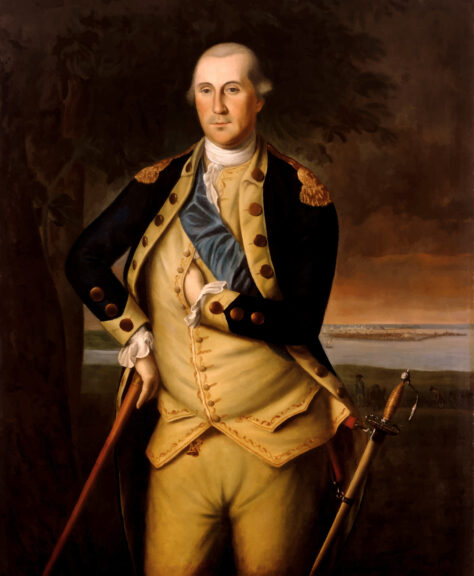
John Parrot/Stocktrek Images. Getty Images.
Unlike Lee, MacArthur or Jackson, Washington’s skills were not those of a tactician. There are no masterpieces of the military arts comparable to Chancellorsville or Inchon in Washington’s repertoire. Indeed, few great generals have actually lost more pitched battles than did His Excellency. In 1776, he was out-maneuvered and almost trapped during the Battle of Long Island. Then, after an American mini-Dunkirk to ferry men across the East River while the British slept, he was repeatedly pushed up and then off of Manhattan Island.
He allowed the losses of Forts Washington and Lee, and watched helplessly as 2,800 of his men were taken prisoner. He then retreated across New Jersey with his disintegrating rag-tag army wherein he hatched a desperate Hail Mary plan to save the flagging rebellion. In trying to protect the capital of Philadelphia from the invading British the following year, he suffered back-to-back defeats at Brandywine Creek (September 1777) and then Germantown (October 1777), allowing the King’s soldiers to march into America’s largest city. In fact, he really only decisively won two outright battles: Trenton in 1776 and then Yorktown in 1781. Monmouth in 1778, was technically a draw, even as the Continentals got the upper hand in the fight.
So, if not for tactical brilliance, what made Washington so indispensable?
One would have to look into the character of the man. He was not just the right man at the right time; he was the only man at the right time. And he was absolutely committed to his cause, even though as one of the wealthiest colonists he stood to lose his fortune, even his life, should the revolution fail.
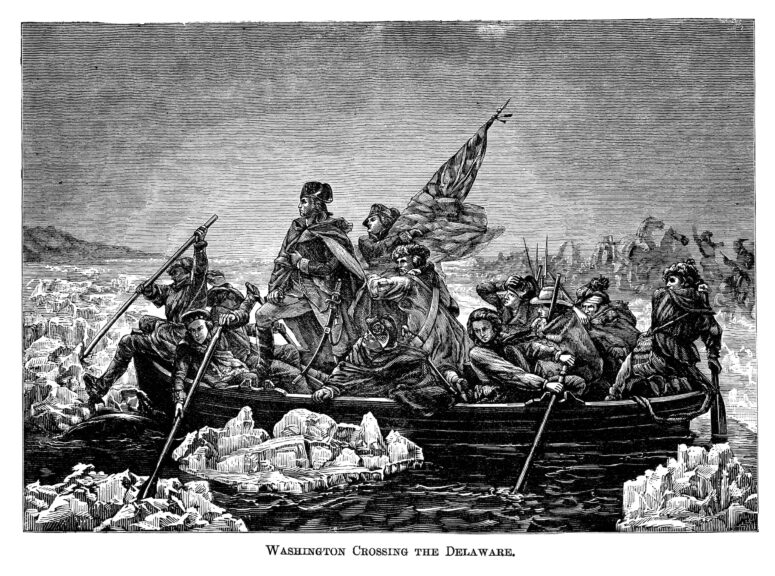
Old engraved illustration of General George Washington crossing the Delaware River during the American Revolutionary War in 1776. Getty Images.
The war lasted an exhausting eight years. And in that time, through seemingly one crisis upon another, Washington through sheer force of will and displays of leadership managed to keep his often ill-clothed, sick, and starved army functioning, and thus keep the cause alive. And though at times he privately despaired about his situation, he never showed this side to his men. In fact, when planning his most desperate attack on the Hessian garrison at Trenton in December 1776, he privately worried that should the attack fail “the game is pretty well up.” The password was “Victory or Death.” It was victory. And through successes in New Jersey at the end of 1776 into the first week of 1777, Washington showed an uncanny ability to revitalize his army, his officers, and the country when it was needed most. His victory at Trenton could be the most important in U.S. history. Indeed, it has been said that never in history has such a small group of men in such a short window of time engaged in fighting that has so changed the course of the world. And that victory would simply not have been possible, or even conceivable, without Washington.
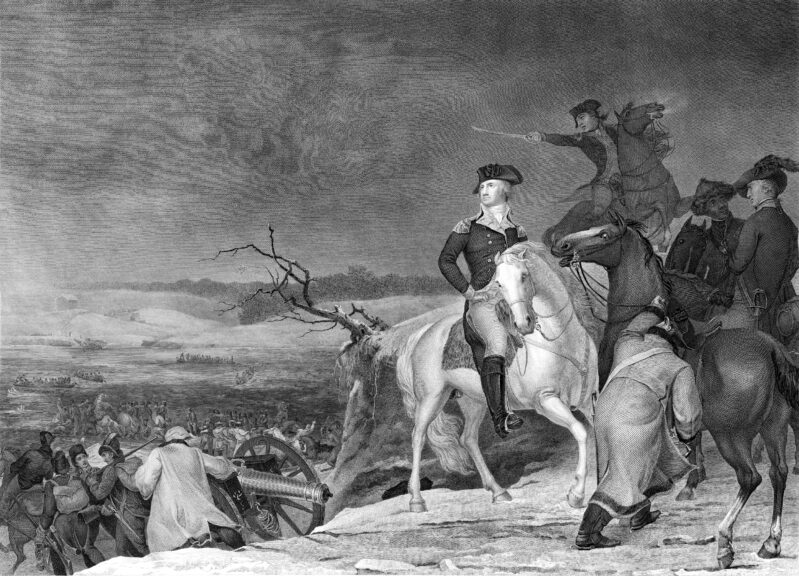
George Washington on horseback looking back at troops crossing the Delaware River on the evening previous to the Battle of Trenton, December 25th, 1776.
Washington’s growth from an inexperienced former colonel of colonial militia to a formidable leader of a disciplined and formidable army is evident. By 1780, he was conducting a continental war. His skill at picking the right men under him, often from unlikely stock, be they a Massachusetts bookseller in Henry Knox or Rhode Island Quaker mill owner in Nathanael Greene, showed a valuable willingness to shed military convention and bias towards professional soldiers in cobbling together such a unique fighting force. His choice of Greene to lead the Southern District of the Continental Army was perhaps one of his most important and inspired of the war given the results that led to Yorktown.
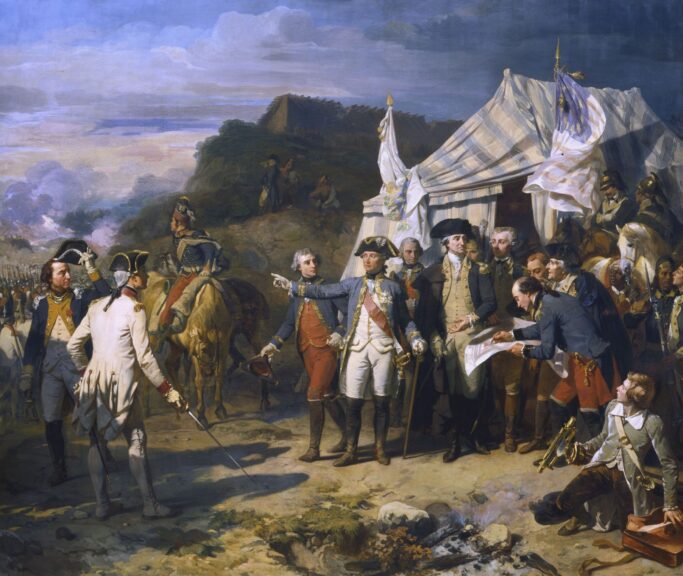
Painting of Siege of Yorktown by Louis-Charles-Auguste Couder
Washington was also flexible enough to listen to counsel. By 1781 he’d become fixated with retaking New York, but when the chance to bag Cornwallis’ entire army at Yorktown in conjunction with the soon-to-arrive French Fleet arose, he wisely took his French counterpart Rochambeau’s advice and abandoned his plans to retake city and march his entire army south. The rest, as they say, is history.

Old engraved illustration of Surrender of Charles Cornwallis to George Washington at Yorktown. mikroman6. Getty Images.
Washington is known as the “father of the country” but he is also the father of the U.S. Military that arose out of the nascent Continental Army. Commanding men from all over the nation and bridging sectional/cultural divides as well as anyone from the Virginia planter elite could, that he simply managed to keep his unique army together for so long, through so much hell and turmoil and struggles and seemingly hopeless situations, is a feat beyond all but the greatest of men. His troops, in the end, fought for him as well as the cause. And he, in turn, fought not for himself, but for his country, one he’d hoped would be better for those men in the ranks than the one they’d left behind.
As is a common theme of this series, Washington led from the front, often dangerously so.
At the battle of Princeton in January 1777, Washington rallied his men by conspicuously riding his white charger down the lines between his own and the British. When the redcoats, just 30 yards away, leveled their muskets and fired a volley, one of the general’s aides confessed he averted his eyes to not see Washington fall. But his 6’2” commander, who would often confess that he was actually exhilarated by the whizzing of deadly bullets around him, remained astride his horse as he would for the entire long, bloody, and seemingly endless war, until the final triumph at Yorktown ensured American independence. Because he never gave up. And because of this one man more than any other storied figure of the American Revolution, a most improbable victory was won, and a new country was born.
Of all the remarkable feats of arms I have listed here, however, none of them are as impressive and as important as what Washington did after the guns fell silent. On 23 December, 1783, to the shock of rulers the world over, this man who had been given almost unlimited power during the war, and who with a loyal army of veteran troops behind him could have installed himself as King of America, resigned his commission and turned command of the Continental Army back over to the civilians in Congress.
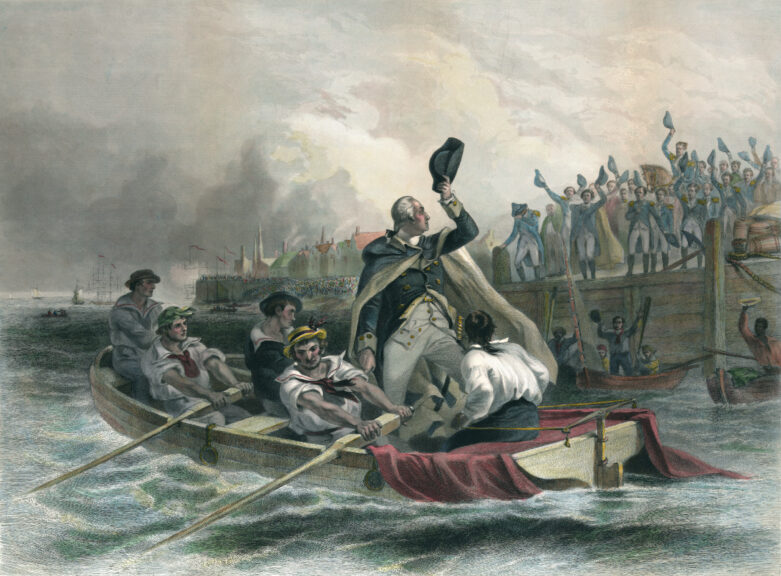
General George Washington leaving Whitehall Ferry on December 4, 1783, to the cheers and waves of his officers. Earlier that day, Washington left his fellow generals, Knox, Steuben, Greene, and then-Colonel Hamilton, at New York’s famed Francis Tavern where he informed them that he will be resigning his commission and returning to civilian life. Keith Lance. Getty Images.
Washington, therefore, established the most important military tradition of all and a bedrock concept of the Republic adhered to by his successors ever since, that is the firm control of the civilian authorities over the military. Supposedly, King George III was incredulous when hearing from a portrait artist that Washington would resign his commission after the war, offering: “If he really does it he’ll be the greatest man in the world.”
He really did it. And he really was.

Portrait of George Washington, first president of the United States from 1789 to 1797. mikroman6. Getty Images.
* * *
America’s Top 11 Generals
RELATED: #6 Admiral Chester Nimitz
RELATED: #5 Thomas ‘Stonewall’ Jackson
RELATED: #4 William T. Sherman
* * *
Brad Schaeffer is a commodities trader, columnist, and author of two acclaimed novels. His newest book, the fact-based LIFE IN THE PITS: My Time as a Trader on the Rough-and-Tumble Exchange Floors will be published in December and is currently available for pre-order. You can also find more of Brad’s articles on Substack.
The views expressed in this piece are those of the author and do not necessarily represent those of The Daily Wire.

Continue reading this exclusive article and join the conversation, plus watch free videos on DW+
Already a member?

.png)
.png)

